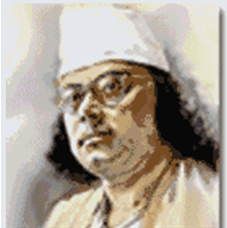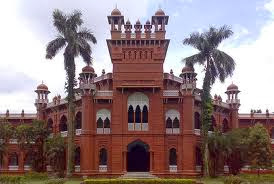Khidr or al-Khidr (Arabic: الخضر al-Khiḍr, also transcribed as Khidr, Khizr, Khyzer, Qeezr, Qhezr, Qhizyer, Qhezar, Khizar, Xızır, Hızır) is a revered figure in Muslim and Islam-influenced areas who is believed to be described in the Quran as a righteous servant of God and he possessed great wisdom or mystic knowledge. In different Islamic and non-Islamic traditions, Khidr is variously described as a messenger, prophet, wali or in some cases, as a "non-abstract" deity[1] who takes the worldly place of the God as a deus otiosus.[2] The figure of al-Khidr has been syncretized over time with various figures including Vishnu in India,[3] Sorūsh in Iran, Saint Sarkis the Warrior and John the Baptist in Armenia,[4] Saint George in Asia Minor and the Levant, etc.[5]
The name "Khidr" is taken colloquially (and sometimes within more scholarly literature) to mean "the Green One" or "the Verdant One" in Arabic; however, this definition is only a popular etymology with no linguistic connection between Khidr and al-akhdar, the Arabic word for green.[6] Another opinion refers to a short or Arabized form of Hasisatra (Atra-Hasis).[7] Hasisatra is the nickname of the "Sumerian Noah" Utnapishtim. He is a character in the Gilgamesh epic who is asked by Enki (Ea) to abandon his world possessions and create a great ship. Therefore he is a survivor of the flood on whom the gods had conferred immortality, at the source of waters.[8] According to Dutch Orientalist Arent Jan Wensinck (1882-1939) the story of Khidr and Alexander the Great is connected with the Gilgamesh Epic. Because, like Alexander the Great, Gilgamesh has searched for immortality and he has tried to find Atrahasis who lived on an island and had the secret of eternal life.[9]
Although there are many common or similar elements between the Gilgamesh epic and the Alexander romance in which 'Khidr' plays a role, Hasisatra is not the prototype of Khidr. Khidr originally comes from Ugaritic mythology and his prototype is Kothar-wa-Khasis (Chusor in Greek), the god of smith and builder;[10] but he is actually associated with Kothar's syncretic forms. The name Khidr has also been compromised with some epithets or personal names from ancient Near Eastern cultures and later may be with Arabic al-akhdar. For example like personal names Hi-zi-ri, Hu-zi-ru (Asur), Aziru, Haziru (Akkad), Ha-zi-ru-um, Hisr (Amorit), Hi-zi-ri (Amarna) which Aramian dr and Hebrew zr means to help. In the texts of Ras Shamra Kothar was known as a helper of Baal; thus he might be hi-zi-ri.[11] But there are more than this possibility; also transforms of the name Kothar are similar the transforms of the name Khidr.[12] One of them is
The name "Khidr" is taken colloquially (and sometimes within more scholarly literature) to mean "the Green One" or "the Verdant One" in Arabic; however, this definition is only a popular etymology with no linguistic connection between Khidr and al-akhdar, the Arabic word for green.[6] Another opinion refers to a short or Arabized form of Hasisatra (Atra-Hasis).[7] Hasisatra is the nickname of the "Sumerian Noah" Utnapishtim. He is a character in the Gilgamesh epic who is asked by Enki (Ea) to abandon his world possessions and create a great ship. Therefore he is a survivor of the flood on whom the gods had conferred immortality, at the source of waters.[8] According to Dutch Orientalist Arent Jan Wensinck (1882-1939) the story of Khidr and Alexander the Great is connected with the Gilgamesh Epic. Because, like Alexander the Great, Gilgamesh has searched for immortality and he has tried to find Atrahasis who lived on an island and had the secret of eternal life.[9]
Although there are many common or similar elements between the Gilgamesh epic and the Alexander romance in which 'Khidr' plays a role, Hasisatra is not the prototype of Khidr. Khidr originally comes from Ugaritic mythology and his prototype is Kothar-wa-Khasis (Chusor in Greek), the god of smith and builder;[10] but he is actually associated with Kothar's syncretic forms. The name Khidr has also been compromised with some epithets or personal names from ancient Near Eastern cultures and later may be with Arabic al-akhdar. For example like personal names Hi-zi-ri, Hu-zi-ru (Asur), Aziru, Haziru (Akkad), Ha-zi-ru-um, Hisr (Amorit), Hi-zi-ri (Amarna) which Aramian dr and Hebrew zr means to help. In the texts of Ras Shamra Kothar was known as a helper of Baal; thus he might be hi-zi-ri.[11] But there are more than this possibility; also transforms of the name Kothar are similar the transforms of the name Khidr.[12] One of them is





















